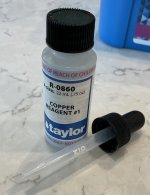Back before I found TFP, I’d take samples to Leslie’s for testing. I’ve since bought my own test kit and have been testing myself. When I was taking water samples to Leslie’s, they’d always be positive for copper. The results varied, anywhere from 0.2 to 1.1 ppm. At one point I drained the pool for an acid wash and after refilling it found no changes in the copper results from Leslie’s. I know, I know, this is shocking!
I bought the Taylor K-1738 copper test kit which returned a completely negative result. My test sample was 42F so being unsure if this test was temperature sensitive like CYA, I warmed another sample by placing the test vial in another container of hot water being sure not to contaminate my sample. After five minutes I got the test sample up to 73F and repeated the test. It turned out again to be negative. Does anyone know if this test is indeed temperature sensitive, and if it is, was my method of warming the sample appropriate? Anything else I may possibly be doing wrong in the test process or is Leslie’s copper test really that bad?
Also, the Taylor K-1738 test kit came with caps for both regents along with two seperate pipets (see example picture below). Is it safe to replace the cap with the pipet for storage of the regent or does storing the regent with the pipet result in a less effective seal?

I bought the Taylor K-1738 copper test kit which returned a completely negative result. My test sample was 42F so being unsure if this test was temperature sensitive like CYA, I warmed another sample by placing the test vial in another container of hot water being sure not to contaminate my sample. After five minutes I got the test sample up to 73F and repeated the test. It turned out again to be negative. Does anyone know if this test is indeed temperature sensitive, and if it is, was my method of warming the sample appropriate? Anything else I may possibly be doing wrong in the test process or is Leslie’s copper test really that bad?
Also, the Taylor K-1738 test kit came with caps for both regents along with two seperate pipets (see example picture below). Is it safe to replace the cap with the pipet for storage of the regent or does storing the regent with the pipet result in a less effective seal?


